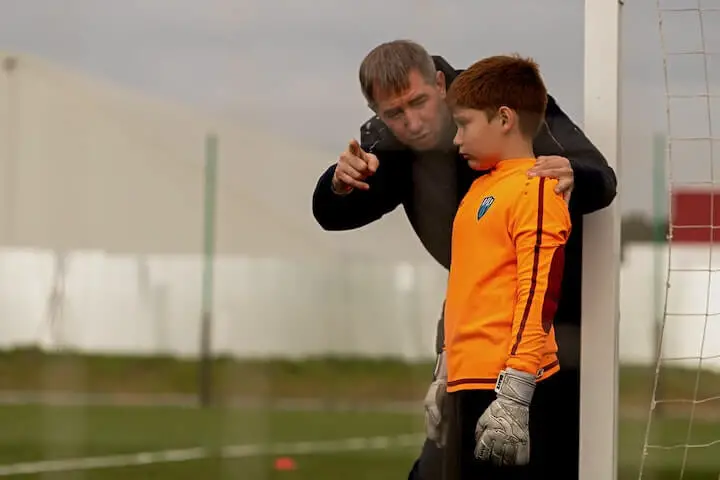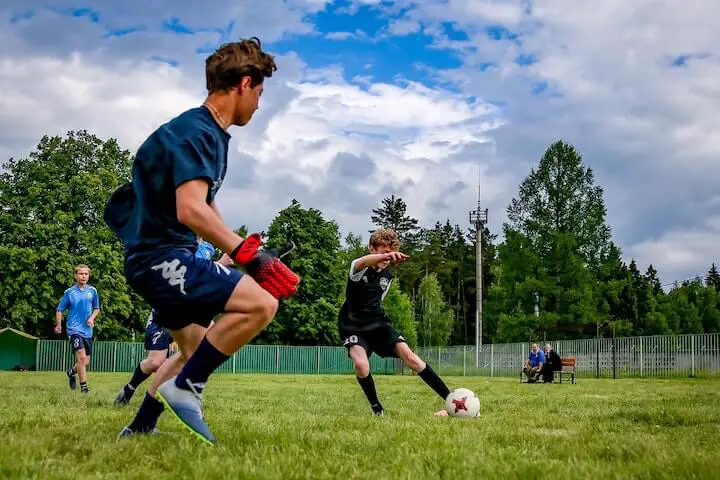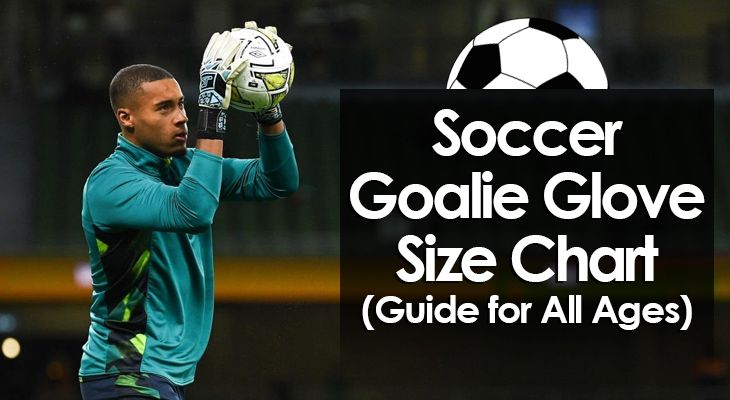Soccer Goalie Glove Size Chart (Guide for All Ages)
As the most isolated player on the field, goalies must do everything in their power to stack the odds in their favor, from being in the correct position in a 1v1 to having the right equipment.
Goalie gloves are the most critical gear a ‘keeper owns.
They provide grip, protection, and leverage whether dealing with a 60mph penalty, catching a looping cross in a crowded penalty box, or getting a fingertip to a well-placed shot.
One of the key aspects of finding the right glove is sizing.
We’ve put together a goalie glove size chart to ensure you get exactly what you need.
Goalie Glove Size Chart Summary
Size | PALM C. | PALM L. | HEIGHT | AGE |
|---|---|---|---|---|
4 | < 3” | > 6” | 4’0” - 4’5” | < 7 |
5 | 3" - 4" | 6” - 6.5” | 4’5” - 4’8” | 7 - 9 |
6 | 4" - 5" | 6.5” - 6.8” | 4’8” - 5’0” | 10 - 12 |
7 | 5" - 6" | 6.8” - 7.2” | 5’0” - 5’3” | 12 - teen |
8 | 6" - 7" | 7.2” - 7.6” | 5’3” - 5’8” | Adult |
9 | 7" - 8" | 7.6” - 8” | 5’8” - 5’11” | Adult |
10 | 8" - 9" | 8” - 8.5” | 5’11” - 6’2” | Adult |
11 | 9" - 10" | 8.5” - 8.9” | 6’2” - 6’4” | Adult |
12 | 10" - 11" | 8.9” + | 6’4” + | Adult |
Finding the right size glove is all about taking your measurements and aligning them with glove manufacturer sizes.
If you’ve never measured your hand size or sized up a pair of goalie gloves, the good news is that all you need is a tape measure.
Here’s a quick summary of the process:
#1 - Measure the circumference of your hand
#2 - Record the length of your hand
#3 - Determine the thickness of your wrist
#4 - Leave some room for comfort and mobility
#5 - Consult the sizing chart

Finding the Right Size Glove
Whether you’re a one-pair-per-season kind of goalie or you use multiple gloves throughout the year, buying new gear is always exciting.
Although you can try on several pairs to get a feel for what you want, using a goalie glove size guide can give you a better indication of comfort and performance in the long term.
Gloves often loosen or tighten after a couple of games or training sessions, so going by an in-store test isn’t necessarily the best approach.
Moreover, many players prefer to buy online to avail of cheaper prices and a broader selection.
Before you start researching different brands and styles, complete the following steps to identify your size.
#1. Measure the Circumference of Your Palm
The first step is to take note of the circumference of the widest part of your hand.
This is usually from the base of your thumb to the bottom of the pinky.
To measure the circumference, here’s what you have to do:
a. Hold one hand in an open position
b. Place the end of the tape measure at the base of your thumb
c. Extend the tape to the bottom of your pinky, holding it tight to your palm
d. Wrap the tape around to the back side of your hand
e. Using roughly the same line as before, pull the tape across the back of your hand until it meets the starting point at the base of your thumb
f. Record the exact distance
g. Round up to the nearest whole number (in inches)
h. Add 1
The final figure gives you an accurate glove size estimation.
For example, if the circumference of the palm is 7.6 inches, round up to 8, and add 1 to get 9. Then, a size 9 glove should be the right fit for your hand.
With that said...
The exact length, width, and general shape of the glove can vary between brands and models.
Therefore, you should also consider the length of your hand and the wrist strap design of each type of glove you’re interested in.
Note: Occasionally people have two different size hands. However, the discrepancy is rarely so big that you’ll require two separate-size gloves. In any case, it’s no harm to measure both hands just in case.
#2. Measure the Length of Your Hand
The length of a goalie glove is from the base of the wrist to the tip of your longest finger.
Wrist straps are measured separately.
Again, use your tape measure and log the exact length of your hand.
Depending on the shape of your hand and your comfort preferences, you’ll likely need to leave a ¼ to ½ inch of space for a comfortable fit.
#3. Consider Wrist Support
People’s wrist sizes vary significantly and often correspond with their height.
However, this isn't always the case as some people have large or small wrists due to genetics and different bone density levels.
Although most glove straps are of a common length and depth, many have different types of closures, some of which offer a more secure fit or additional support.
Hook and loop straps are standard fasteners that allow you to find the right fit quickly and easily. They are best suited to someone with regular to large wrists.
V-notch straps feature elastic or latex cords, allowing a more secure and supportive fit. The v-notch also has a vented entry that provides breathability, which is extremely useful for someone with large wrists.
Bandage closures contain inner elastic bands for improved wrist support and protection. The additional layers pad the wrist, making bandage straps an excellent option for someone with a smaller bone structure. These bandages are typically made with breathable fabrics to keep your hands cool.
#4. Consult the Goalie Glove Size Chart
Once you’ve recorded your measurements, consult the goalie glove size chart to find the perfect size for you.
It’s important to remember that the exact size measurements depend on the brand and design, so make sure to read the dimensions of the gloves before making a purchase.
While you might be drawn toward the aesthetic of a certain brand or want to follow in the footsteps of your favorite stopper, fit and performance should be the priority.
The goalie glove size chart is an excellent tool to identify your size but it’s not an exact science.
You should also check the measurement details of your available options and choose the glove that aligns with your hand size and performance needs.
If you find that you’re between sizes, lean on your preferences and choose whether you prefer a tight or loose fit.
Many professional goalies wrap their hands ahead of a game which provides extra support and may make a loose-fitting glove snugger.

Other Considerations
Other factors to consider when purchasing new goalie gloves include:
- Glove cut
- Thumb size
- Finger protection
- Ventilation
- Glove material
- Weather and playing conditions
Conclusion
All goalkeeper gear should be fit for purpose, especially when it comes to gloves.
Too tight and they can restrict movement and cause discomfort, reducing your feel for the ball.
While purchasing a pair that are too loose will diminish your grip significantly and may lead to frequent spills or fumbles at crucial times.
By using our goalie glove size chart above, you can identify the exact size your need, ensuring your hands make optimal contact with the ball at all times.
This will give you confidence whether you're completing goalie drills at practice or there's 5 minutes to go in an intense game.
Although personal preference should be considered, keep in mind that the perfect fit is typically somewhere between close fitting and slightly loose.

